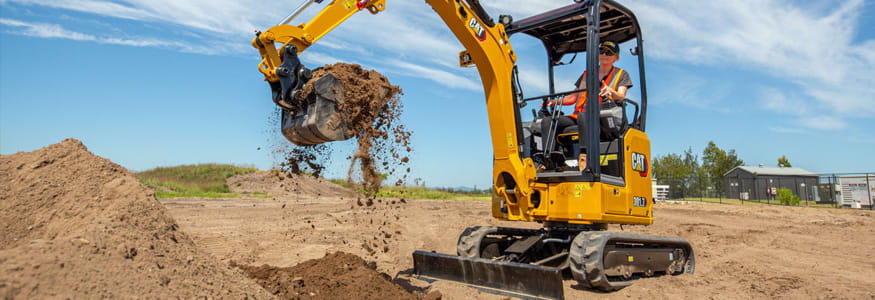How to lift safely with your Cat Next Gen Mini Excavator


Safety is one of our core values at WesTrac. We’ve recently had a customer ask us about the safest way to operate their new Cat Next Gen Mini Excavator when lifting heavy objects. This was such a great question, we wanted to provide a few tips to ensure our customers are lifting the right way and staying safe.
Cat Next Gen Mini Excavators all come with enhanced performance and increased lifting capacity. They are powerful machines that are perfect for a variety of applications, from tight access excavation to building rocky bike trails. If you have a heavy load to lift, provided you follow the five tips below, you’ll be able to get more work done than ever before - #LetsDoTheWork.
Australian Standard AS1418 .8 provides the minimum requirements applicable to the lifting of freely suspended loads with earth moving machinery. Each excavator configured by WesTrac for delivery is assessed in conformance with this standard. Working Load Limits (WLL) are calculated accordingly and posted on the boom and within the operator’s compartment.
To maximise the WLL whilst ensuring the lift remains stable throughout the machines entire operating envelope, the assessment assumes a hitch only lift (no implements) and the worst-case stability scenario (i.e. undercarriage retracted with blade up). In order to ensure operational stability, freely suspended loads should always be kept within the bounds of the WLL.
Note: Some heavier third-party hitches, particularly tilt hitches, may reduce WLL significantly. Careful consideration should be given when specifying machine requirements.
Detailed lifting capacity charts are provided in the Operation and Maintenance Manual (OMM) for each excavator. These charts provide a general indication of the machine’s capacity in various configurations and at different reaches. In most instances the lifting capacity within these charts will exceed the WLL applied to freely suspended loads.
It is the machine operator’s responsibility to understand these tables and apply them to the job at hand. Once the configuration and reach required for the job at hand is understood, the appropriate table can be selected, and the lifting capacity identified. These limits then need to be adjusted by the operator to accommodate for variances in hitch and implement weights.
When lifting with your excavator, blade positioning has an impact on lifting capacity. Generally, if your blade is positioned low, your lift capacity is increased. If your blade is positioned up, your lift capacity is decreased. How much it is increased or decreased by will be outlined in the machine’s lift capacity chart and should be considered before you attempt to lift something heavy.
An excavator’s lift capacity chart assumes an operator is sitting in the cab. In most tables, it assumed that an operator weighing at least 75kg is using the machine. If nobody is sitting in the excavator, this greatly reduces the excavator’s lift capacity and makes it unstable.
If you see a video or photo of an unstable excavator and there is no operator in the cab, that’s one of the main reasons why the excavator may look unstable.
An excavator’s lift capacity is reduced depending on the weight of any attachments added to the machine. If attachments, like a hitch and bucket, are added, the excavator’s lift capacity would need to be re-calculated (by the operator) to ensure safe operation.
If you have a heavy load, take your attachments into consideration and perhaps try using lighter attachments (if possible), or remove your attachments and use the certified lifting eye, fitted to Cat Next Gen Mini Excavators.
Cat mini excavators will help you lift more. Just ask self-proclaimed gym legend “Jim Rat” Rogers. He saw this first-hand when he came across a Cat 306 CR. Check out the video below.